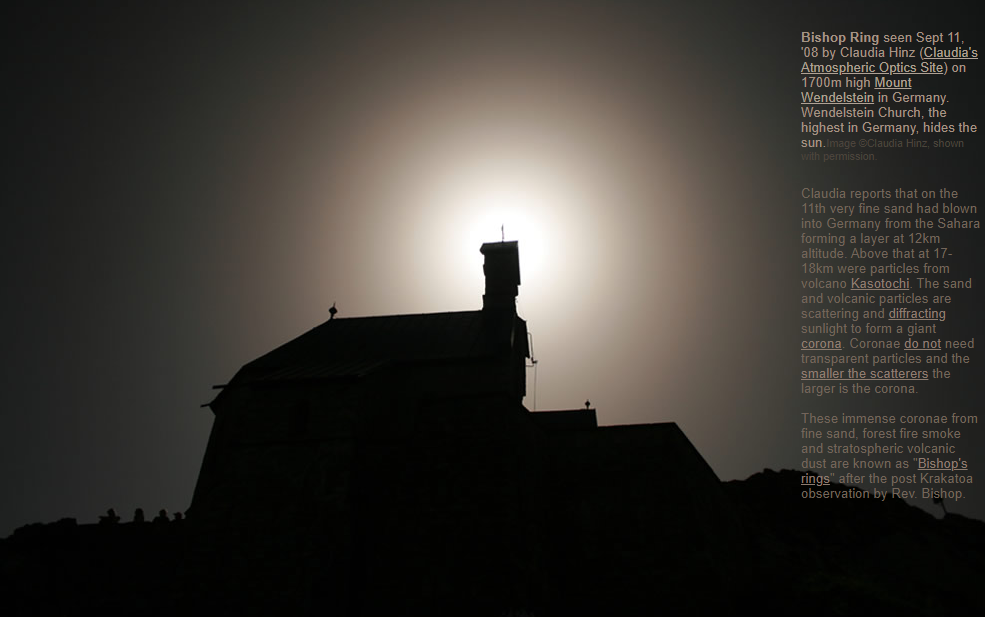Bishop & Church
The Beauty of Bishop Rings: Exploring Atmospheric Optics
Have you ever looked up at the sky and been captivated by the stunning display of colors and patterns? Atmospheric optics is a fascinating field that delves into the science behind these breathtaking phenomena. One such phenomenon is the Bishop Ring, named after the observation made by Rev. Bishop following the Krakatoa volcanic eruption. In this article, we will dive deeper into the world of Bishop Rings and uncover the intricate details that make them so awe-inspiring.
What are Bishop Rings?
Bishop Rings, also known as coronae, are immense circular halos of light that form around the Sun or Moon. These rings are created when sunlight or moonlight passes through tiny particles suspended in the Earth's atmosphere. The size of the particles determines the size of the corona, with smaller particles resulting in larger rings. Unlike other atmospheric optics phenomena, such as rainbows or halos, Bishop Rings do not require transparent particles for their formation.
The Role of Fine Sand, Smoke, and Volcanic Dust
The formation of Bishop Rings often involves a combination of different particles in the atmosphere. In some instances, fine sand blown in from distant deserts, like the Sahara, can play a role in creating these stunning displays. Similarly, smoke from forest fires can contribute to the scattering and diffraction of sunlight, leading to the formation of coronae. Additionally, particles from volcanic eruptions, such as the Kasatochi volcano, can reach high altitudes in the stratosphere and interact with sunlight to produce Bishop Rings.
Claudia Hinz's Observation on Mount Wendelstein
One remarkable observation of a Bishop Ring was made by Claudia Hinz on September 11th, 2008, atop Mount Wendelstein in Germany. Situated at an elevation of 1700 meters, Mount Wendelstein offers a unique vantage point to witness atmospheric phenomena. On that particular day, Claudia noticed a layer of very fine sand from the Sahara at an altitude of 12 kilometers. Above this layer, particles from the Kasatochi volcano at 17-18 kilometers added to the atmospheric composition. The interaction between these particles and sunlight resulted in the formation of a giant corona, with the Wendelstein Church providing a striking silhouette against the Sun.
The Influence of Particle Size
The size of the particles present in the atmosphere plays a crucial role in determining the size and appearance of Bishop Rings. As mentioned earlier, smaller particles lead to larger coronae. This phenomenon can be explained by the principles of scattering and diffraction. When sunlight encounters these minuscule particles, it undergoes scattering and diffraction, causing the light to spread out and form a ring of colors around the source. The larger the particles, the less pronounced the effect, resulting in smaller rings.
Bishop Rings and Atmospheric Composition
Bishop Rings serve as a visual indicator of the composition of the Earth's atmosphere at different altitudes. By studying these rings, scientists can gain insights into the presence of various particles and their distribution. For example, the observation made by Claudia Hinz revealed the simultaneous existence of fine sand from the Sahara and volcanic particles from Kasatochi at different altitudes. This information provides valuable data for atmospheric research and helps deepen our understanding of atmospheric dynamics.
Other Factors Affecting Bishop Rings
While particles in the atmosphere are the primary factor in the formation of Bishop Rings, other conditions can also influence their appearance. The angle at which sunlight or moonlight passes through the atmosphere, as well as the overall atmospheric conditions, can impact the size, shape, and intensity of these rings. Additionally, factors such as air pollution, moisture content, and temperature variations can contribute to variations in the appearance of Bishop Rings.
In conclusion, Bishop Rings are a captivating atmospheric optics phenomenon that showcases the interplay between sunlight, particles in the atmosphere, and unique environmental conditions. The combination of fine sand, smoke, and volcanic dust can create these magnificent rings of light, adding a touch of magic to our skies. By studying Bishop Rings, scientists can unravel the intricacies of our atmosphere and gain valuable insights into its composition and dynamics. So, next time you find yourself gazing up at the sky, take a moment to appreciate the beauty of Bishop Rings and the wonders of atmospheric optics.

Bishop Ring seen Sept 11, '08 by Claudia Hinz (Claudia's Atmospheric Optics Site) on 1700m high Mount Wendelstein in Germany. Wendelstein Church, the highest in Germany, hides the sun.Image ©Claudia Hinz, shown with permission.
Claudia reports that on the 11th very fine sand had blown into Germany from the Sahara forming a layer at 12km altitude. Above that at 17-18km were particles from volcano Kasotochi. The sand and volcanic particles are scattering and diffracting sunlight to form a giant corona. Coronae do not need transparent particles and the smaller the scatterers the larger is the corona.
These immense coronae from fine sand, forest fire smoke and stratospheric volcanic dust are known as "Bishop's rings" after the post Krakatoa observation by Rev. Bishop.
Note: this article has been automatically converted from the old site and may not appear as intended. You can find the original article here.
Reference Atmospheric Optics
If you use any of the definitions, information, or data presented on Atmospheric Optics, please copy the link or reference below to properly credit us as the reference source. Thank you!
-
<a href="https://atoptics.co.uk/blog/bishop-church/">Bishop & Church</a>
-
"Bishop & Church". Atmospheric Optics. Accessed on April 20, 2024. https://atoptics.co.uk/blog/bishop-church/.
-
"Bishop & Church". Atmospheric Optics, https://atoptics.co.uk/blog/bishop-church/. Accessed 20 April, 2024
-
Bishop & Church. Atmospheric Optics. Retrieved from https://atoptics.co.uk/blog/bishop-church/.